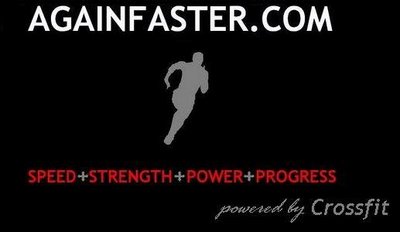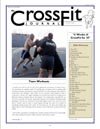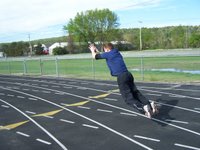Pursuing Power

“Speed, Strength, Power, Progress”. It’s a simple motto that represents a complex mission. We want to develop three global physical qualities in an effort to become better athletes, using any and all means at our disposal.
I’ve shown the relevance of power of several occasions. Power is the very core of fitness, a suitable proxy for nearly any objective measure of athletic prowess. As a rule, the fittest athletes are those that generate the most power. Power is equal to force multiplied by displacement divided by time:
Power = (force * displacement)/time
Power takes into account the first two qualities mentioned in our motto—strength and speed. Strength is the ability to generate force, while speed is the total distance covered in a given amount of time:
Strength = force
Speed = displacement/time
Given these definitions, we can reduce power to two components—speed multiplied by strength:
Power = speed * strength
The critical factor in developing power and improving your fitness level is strength. This quality is prerequisite to both power and speed.
Without the ability to generate a significant amount of force, the power equation approaches zero. Similarly, a lack of force severely limits displacement, pushing the speed portion of the equation toward zero.
Given this reality, the beginning athlete must develop a strength base prior to reaching any appreciable level of fitness. This necessity is shown through empirical observation—athletes who come to Crossfit from strength backgrounds—gymnastics, football, wrestling, bodybuilding, etcetera—progress much faster than those who come from endurance backgrounds. They produce relatively greater force and therefore greater power, the end result being greater fitness.
That said, the vast majority of Crossfitters arrive with extensive endurance training and comparatively limited strength training. Their first task, beyond learning our stable of movements, is strength development.
Under the watchful eye of a trainer, this is easy. Show up everyday and do what you’re told.
For those without the good fortune of professional instruction, the process is more difficult. Enterprising athletes will search the Internet for information, typically finding a few million programs, each prescribing a proprietary method of developing strength. Understandably, they walk away confused, paralyzed by millions of choices presented millions of ways.
The industry benefits from the confusion, selling software, books, logs, and articles with the promise that a few hundred dollars is all that separates the novice from the world’s best strength system.
It’s total bullshit. For the beginner, the reverse pyramid double wave periodized triple drop set holds no more benefit than three sets of ten twice a week. The only thing the rank beginner needs to do for the first few months is lift. After this magical “anything works” period, a basic understanding of strength development comes in handy.
Strength is the result of two interrelated factors—neurological development and muscular cross-section.
As the athlete lifts more often, the body recruits more muscle fibers to assist with the movement—it learns to use your existing muscle mass more efficiently. Additional neurological connections develop, and your body reaches its maximum capacity to generate force in its current state.
Muscle size also increases—its cross-section becomes larger. This is known as hypertrophy. Every time the athlete lifts, the employed muscles are traumatized, creating small tears. As these tears heal, additional muscle mass is created. This mass comes in two forms—new muscle fibers and the enlargement of existing muscle fibers.
The nervous system acts on the new muscle as well as the old muscle, producing relatively greater force with each contraction. Strength is the result.
Given our knowledge of strength development, we know it requires two behaviors—lifting frequently enough to create micro-trauma and lifting heavy enough to facilitate neurological development. Even more simply, we have to lift a lot of weight as often as possible.
The limiting factor is healing—we cannot lift maximal loads every day. Our bodies would turn to mush exceedingly quickly. Due to this fact, athletes must periodize their strength training. This is a fancy way of saying they have to take it easy every once in a while—they have to decrease training volume to allow for healing once every few weeks.
The community gives a lot of attention to rep schemes in an effort to find the training “sweet spot”. High repetitions with low weights tend to produce increased muscle mass, while low repetitions with high weights tend to facilitate neurological development. Obviously, trainees want both, and everyone wants the magic bullet--a program that takes care of both qualities simultaneously.
The Crossfit Community has latched onto the 5 by 5 as the solution—five sets of five repetitions using a load of 80-85% of the athlete’s one-repetition maximum. This represents a well-reasoned compromise between hypertrophy and neurological development—the middle ground of strength training.
For the beginning athlete, this is a great place to start. Strength gains come quickly using this method. Nonetheless, don’t get hung up on the 5 by 5 as the only solution to your strength needs.
Working above 90% of your one-repetition maximum is critical to continued neurological improvement, and working below 80% is critical to hypertrophy. Both qualities are required for high absolute strength levels.
I’ve used several strength programs to good effect. The Mass Gain Program, contained in Issue 17 of the Performance Menu gave me great results, although I compromised the hypertrophy portion of the program through excessive metabolic activity.
More recently, I’ve begun the Hatch Squat Program, a hell-worthy combination of back squats and front squats performed twice a week for twelve weeks. My thanks to Mike's Gym for making the program available to the masses.
Looking at these two programs, you’ll see my preference for full-body, compound movements. They are the quickest way to total body strength, and the only way a Crossfit athlete should train.
Remember, we’re pursuing power. Develop your strength base, and you’ll reap the rewards—increased speed, reduced workout times, and monumental power output.
Go faster!
Picture courtesy of weights.eusu.ed.ac.uk. The deadlift stands as the most functional pure strength movement on earth.

“Speed, Strength, Power, Progress”. It’s a simple motto that represents a complex mission. We want to develop three global physical qualities in an effort to become better athletes, using any and all means at our disposal.
I’ve shown the relevance of power of several occasions. Power is the very core of fitness, a suitable proxy for nearly any objective measure of athletic prowess. As a rule, the fittest athletes are those that generate the most power. Power is equal to force multiplied by displacement divided by time:
Power = (force * displacement)/time
Power takes into account the first two qualities mentioned in our motto—strength and speed. Strength is the ability to generate force, while speed is the total distance covered in a given amount of time:
Strength = force
Speed = displacement/time
Given these definitions, we can reduce power to two components—speed multiplied by strength:
Power = speed * strength
The critical factor in developing power and improving your fitness level is strength. This quality is prerequisite to both power and speed.
Without the ability to generate a significant amount of force, the power equation approaches zero. Similarly, a lack of force severely limits displacement, pushing the speed portion of the equation toward zero.
Given this reality, the beginning athlete must develop a strength base prior to reaching any appreciable level of fitness. This necessity is shown through empirical observation—athletes who come to Crossfit from strength backgrounds—gymnastics, football, wrestling, bodybuilding, etcetera—progress much faster than those who come from endurance backgrounds. They produce relatively greater force and therefore greater power, the end result being greater fitness.
That said, the vast majority of Crossfitters arrive with extensive endurance training and comparatively limited strength training. Their first task, beyond learning our stable of movements, is strength development.
Under the watchful eye of a trainer, this is easy. Show up everyday and do what you’re told.
For those without the good fortune of professional instruction, the process is more difficult. Enterprising athletes will search the Internet for information, typically finding a few million programs, each prescribing a proprietary method of developing strength. Understandably, they walk away confused, paralyzed by millions of choices presented millions of ways.
The industry benefits from the confusion, selling software, books, logs, and articles with the promise that a few hundred dollars is all that separates the novice from the world’s best strength system.
It’s total bullshit. For the beginner, the reverse pyramid double wave periodized triple drop set holds no more benefit than three sets of ten twice a week. The only thing the rank beginner needs to do for the first few months is lift. After this magical “anything works” period, a basic understanding of strength development comes in handy.
Strength is the result of two interrelated factors—neurological development and muscular cross-section.
As the athlete lifts more often, the body recruits more muscle fibers to assist with the movement—it learns to use your existing muscle mass more efficiently. Additional neurological connections develop, and your body reaches its maximum capacity to generate force in its current state.
Muscle size also increases—its cross-section becomes larger. This is known as hypertrophy. Every time the athlete lifts, the employed muscles are traumatized, creating small tears. As these tears heal, additional muscle mass is created. This mass comes in two forms—new muscle fibers and the enlargement of existing muscle fibers.
The nervous system acts on the new muscle as well as the old muscle, producing relatively greater force with each contraction. Strength is the result.
Given our knowledge of strength development, we know it requires two behaviors—lifting frequently enough to create micro-trauma and lifting heavy enough to facilitate neurological development. Even more simply, we have to lift a lot of weight as often as possible.
The limiting factor is healing—we cannot lift maximal loads every day. Our bodies would turn to mush exceedingly quickly. Due to this fact, athletes must periodize their strength training. This is a fancy way of saying they have to take it easy every once in a while—they have to decrease training volume to allow for healing once every few weeks.
The community gives a lot of attention to rep schemes in an effort to find the training “sweet spot”. High repetitions with low weights tend to produce increased muscle mass, while low repetitions with high weights tend to facilitate neurological development. Obviously, trainees want both, and everyone wants the magic bullet--a program that takes care of both qualities simultaneously.
The Crossfit Community has latched onto the 5 by 5 as the solution—five sets of five repetitions using a load of 80-85% of the athlete’s one-repetition maximum. This represents a well-reasoned compromise between hypertrophy and neurological development—the middle ground of strength training.
For the beginning athlete, this is a great place to start. Strength gains come quickly using this method. Nonetheless, don’t get hung up on the 5 by 5 as the only solution to your strength needs.
Working above 90% of your one-repetition maximum is critical to continued neurological improvement, and working below 80% is critical to hypertrophy. Both qualities are required for high absolute strength levels.
I’ve used several strength programs to good effect. The Mass Gain Program, contained in Issue 17 of the Performance Menu gave me great results, although I compromised the hypertrophy portion of the program through excessive metabolic activity.
More recently, I’ve begun the Hatch Squat Program, a hell-worthy combination of back squats and front squats performed twice a week for twelve weeks. My thanks to Mike's Gym for making the program available to the masses.
Looking at these two programs, you’ll see my preference for full-body, compound movements. They are the quickest way to total body strength, and the only way a Crossfit athlete should train.
Remember, we’re pursuing power. Develop your strength base, and you’ll reap the rewards—increased speed, reduced workout times, and monumental power output.
Go faster!
Picture courtesy of weights.eusu.ed.ac.uk. The deadlift stands as the most functional pure strength movement on earth.




















1 Comments:
A great, concise article on gaining strength and developing power. Thank you for posting it. It should be mandatory reading for every new person coming to CF or who wants to develop strength (and/or power).
Post a Comment
<< Home